Strawberry Puree (No blender) for Cakes and Desserts




Strawberry puree is made by cooking strawberries with sugar. The heating dissolves and melts the sugar in the water contained in the strawberries. It also evaporates water, creating a thick red syrup containing strawberry solids. The resulting puree is concentrated in color, texture, and strawberry flavor.
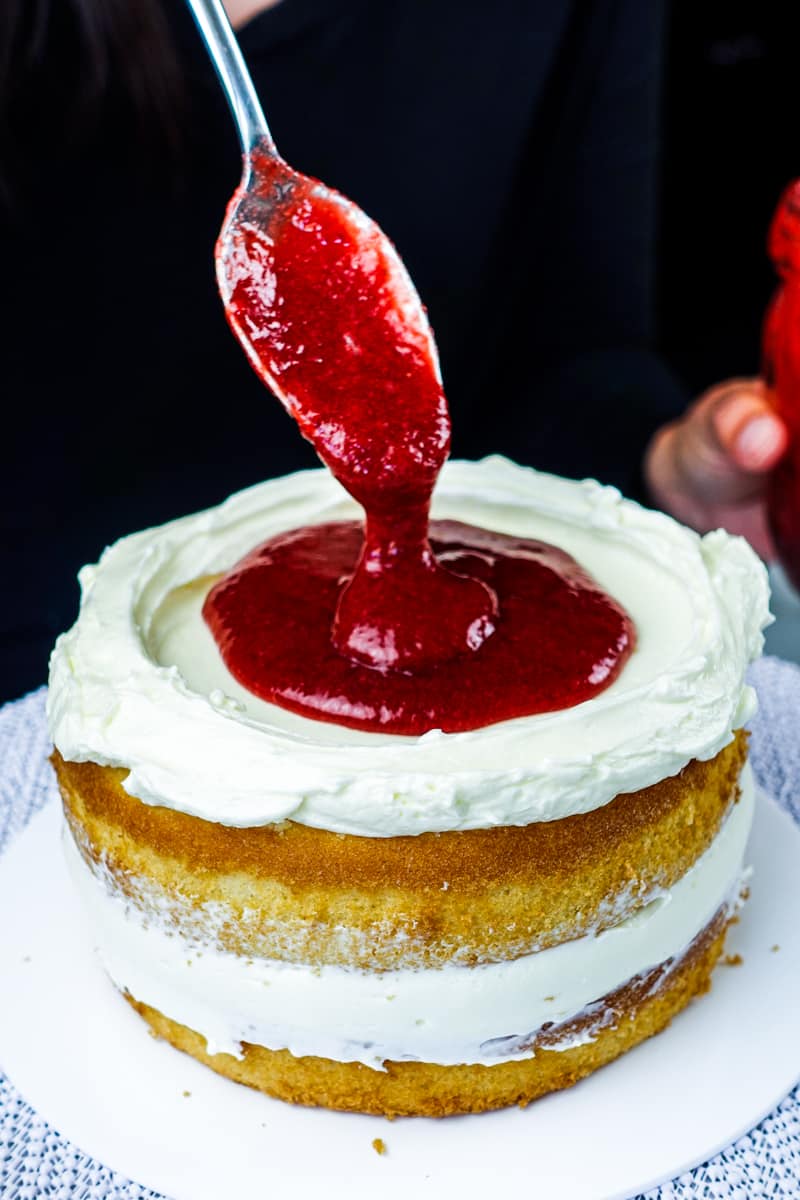
Whether you have strawberries that need to be used up or a recipe that requires strawberry puree, this is the recipe for you. It comes together in minutes with no fancy equipment (blender or food processor) and uses only a few ingredients.
What ingredients go into strawberry puree?

- Strawberries - you can use either fresh or frozen; they will both create delicious purees, so use what you have access to. If you’re out of strawberry season for your area, frozen strawberries are a great choice. (Costco has a pretty good price for a big frozen bag.)
- Sugar - I use either white or brown; it doesn’t really matter. The brown sugar has that earthy-sweet flavor from the molasses. Both will dissolve just fine in the strawberry juice.
- Lemon juice - optional but aids in both flavor and maintaining a red color. This is because citric acid is already in many fruits and complements the floral strawberry flavor. Citric acid also helps maintain a low pH, which is important for the red color.
How I store my strawberry puree
After making my strawberry puree recipe, if not using immediately, I will pour it into a glass container like a mason jar and store it in my fridge.
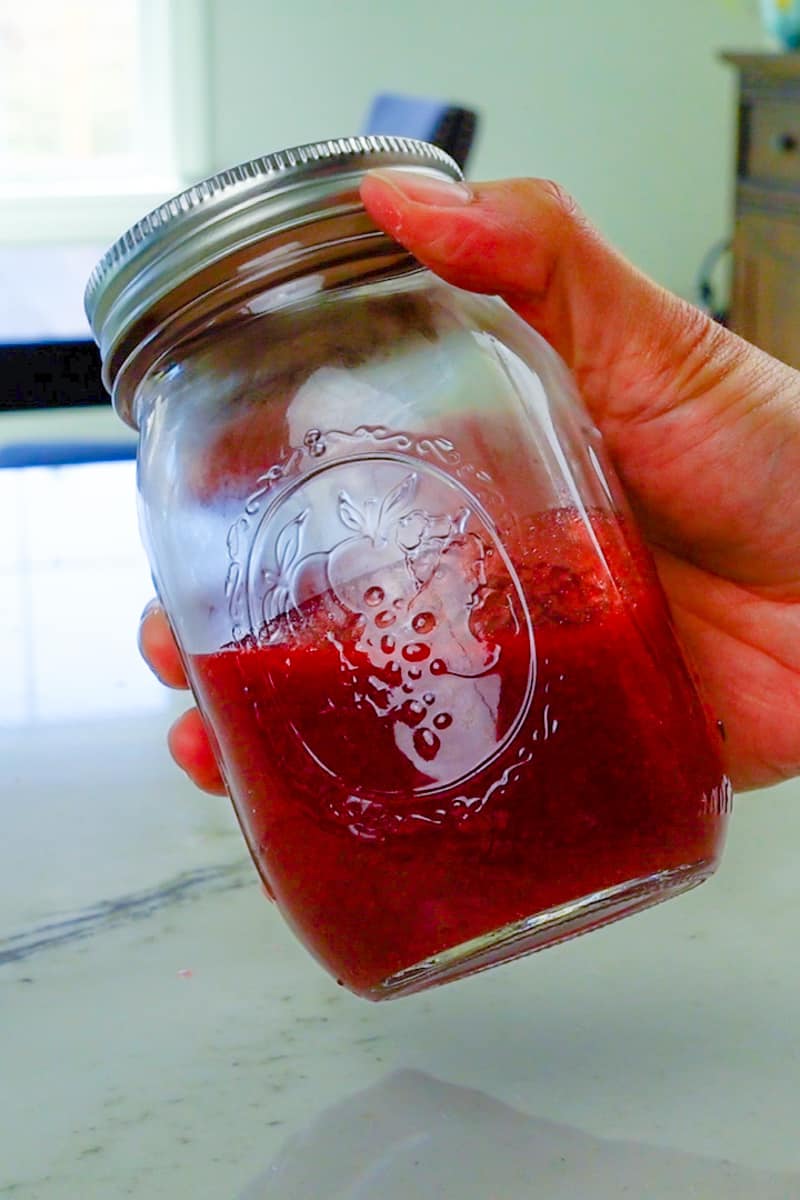
You can also make strawberry puree to save in the freezer for long term storage. For that you can use freezer-safe zip top bags or special containers made for long term freezer storage.
How long does strawberry puree last?
In an airtight container and stored in the fridge, strawberry puree should last at least a few weeks. Typically when you have heated a mixture, added lots of sugar, removed the water, and kept it chilled, it prevents microbial growth. (This is the process that home canners know very well, allowing them to store and preserve all kinds of things.)
How to use the strawberry puree for cake
Cakes are probably my favorite way to use strawberry puree, but I’m a bit biased since cakes are my focus right now :)
Strawberry puree adds freshness and acidity to a cake, creating complexity in overall flavor and counterbalancing sweetness.
Can you add strawberry puree directly to cake batter/cake mix?
You can, but unless you know the cake recipe pretty well, it’s difficult to say whether or not it will negatively affect the texture and rise of the cake.
Strawberry puree adds extra sugar (sugar = moisture) and strawberry solids (adds to the starch content) to a cake batter.
It may mess up the ratios if the recipe hangs in a delicate balance where exact moisture and starch content are required for a specific texture.
Box cake mix is the one type of cake I’d say is ok to add the puree directly to the cake batter. Those mixes are insanely (and almost unbelievably) stable. They can withstand all substitutions and additions and still come out fantastic. (TIP: You may have to add some pink food coloring to achieve a pinkish rather than gray cake. Strawberries are sensitive to the pH of cake batters, which is a video I’m editing right now.
If this stuff interests you by the way - come nerd out with me on my baking science YouTube channel)
Have a made-from-scratch cake recipe you love that you want to add strawberry puree to?
Try this:
1. Use the strawberry puree as cake filling. Not only will it give a stronger punch of strawberry flavor, since you’re not adding it to the batter, it has no impact on the cake recipe itself so you can just bake it as you are use to.
For cupcakes, just cut out the centers and use a piping bag or small spoon to add a bit of the puree into the cupcake. Frost as you normally would.
For layer cakes, pipe a dam of buttercream around the perimeter of the cake layers, then pour in some of the puree. The dam is to ensure the puree doesn’t drip down the sides of the cake, but that’s a vibe in and of itself, so go for that if you want a naked style drip cake.
2. Swirl the strawberry puree in the batter. After pouring the batter into your cake or cupcake pans, drizzle some puree over the batter. Use a skewer or toothpick to swirl the puree around. The finished cakes with have these beautiful swirls of concentrated strawberry flavor intertwined within the crumbs.
The cool thing about these two suggestions is that it gives you the chance to easily combine flavors.
How about:
lemon cake + strawberry puree swirl + lemon buttercream = Strawberry Lemonade Cake
matcha cake + strawberry puree filling + vanilla whipped cream = Matcha Strawberry Cake
If you’d like to use any of my recipes, I have a web app called The Cakeculator. It lets you choose the pan size and flavor of a cake and build your own cake recipe. You can use the strawberry puree in any of my cake flavors that you like, located on my Cakeculator here.
How to use strawberry puree in frostings and buttercreams?
Most buttercreams contain so much butter that they can withstand more liquid added to them. Start by adding a tablespoon of your puree to room temperature buttercream. Mix on low speed and taste along the way.
Typically emulsion-type frostings are best, so those are your Italian, Swiss, and French buttercreams.
Emulsions are super stable mixtures of butter and other ingredients and can withstand a higher proportion of water-based ingredients (that would be your strawberry puree).
If you’re all about American buttercream, you can add strawberry puree to that, just not as much.
I suggest two ways to add strawberry puree to a cheesecake: before baking by swirling or post-baking by drizzling on the surface.
To swirl the puree in a classic New York-style cheesecake:
- Add it to the batter after pouring the uncooked batter into the springform pan.
- Drizzle some of the strawberry puree atop the batter and use a long skewer to swirl the puree.
- Bake as you normally would.
If you want to add the puree post-baking, allow the cheesecake to cool completely and remove it from springform as indicated in the recipe. Pour the puree atop the cheesecake to get a drippy effect.
If you’re looking for a good New York cheesecake recipe, I use this one here by Emojoie cuisine. You can also see how he uses raspberry puree after the cheesecake it baked.
How to use strawberry puree for drinks?
I’m throwing this idea in here because my kids adore any and all drinks with strawberries. You can add it to milkshakes, but their favorite way is to make fresh strawberry milk.
This is their favorite boba shop drink, but I also love to make it at home for them.
Just pour some puree into the bottom of a tall glass (a few tablespoons) and fill it to the top with any milk of your choice. Stick a straw in there, and you’ll have one happy kid.
Step by step:
How to make homemade strawberry puree
The gist of my strawberry puree recipe is that we’re using heat to melt and dissolve the sugar in the water inside strawberries.
Strawberries are relatively high in water content, so there’s no need to add extra water to your puree. In fact, we want to do the opposite - so much water that we want to evaporate some of it. In the cooking world, this is called a ‘reduction’ as we reduce the amount of water in a mixture.
You also don’t need extra equipment because the heat is excellent at breaking down most of the strawberries. I prefer this thicker, jammy puree, but if you need a super smooth puree, feel free to blend or process your strawberries before adding it to the saucepan in Step 1.
Step 1: Break down strawberries with heat. Add strawberries and sugar to a saucepan.
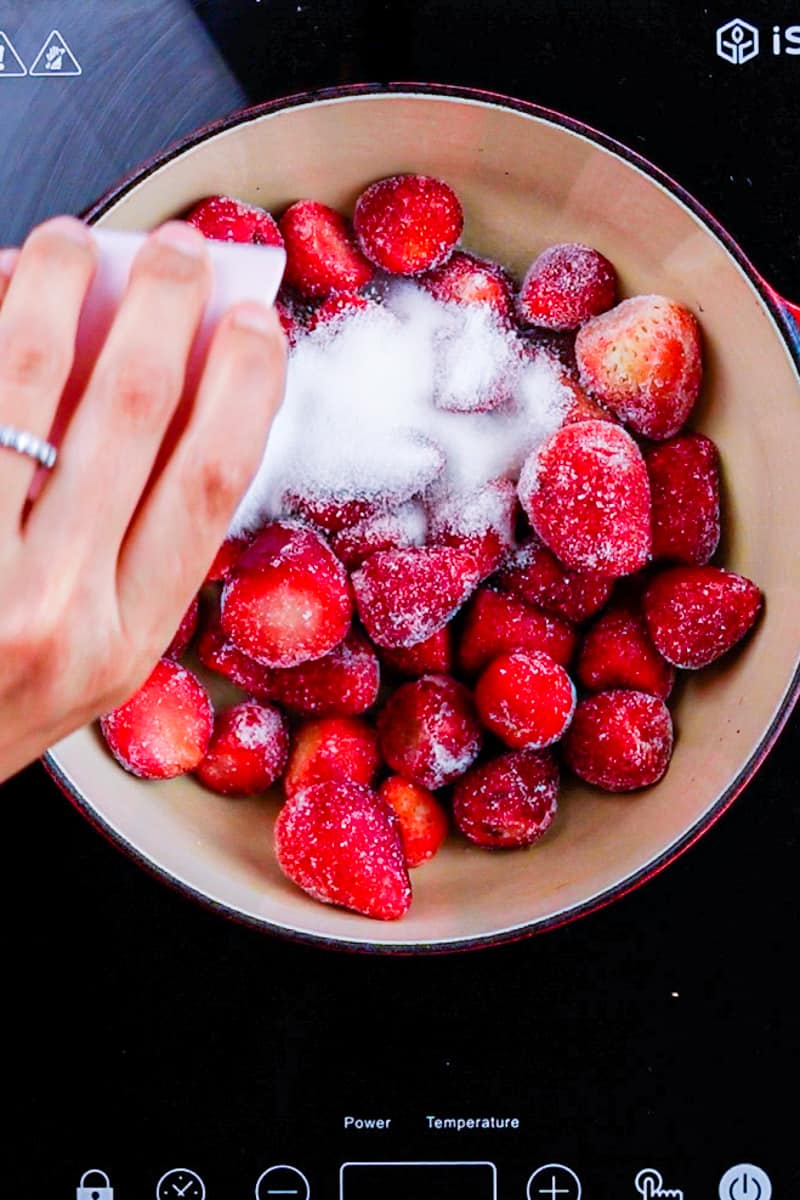

Step 2. Break down strawberries with fork. Cook on medium heat periodically mashing.
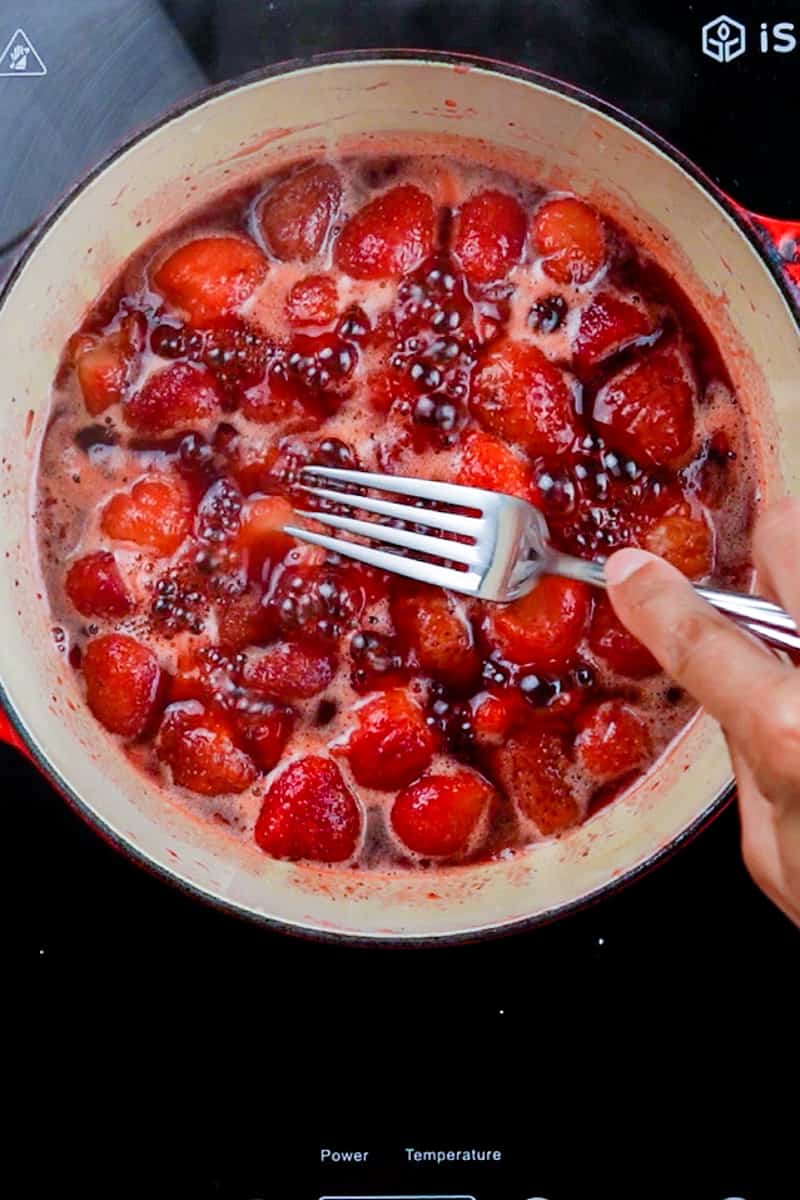
(Optional) Step 3. Remove unwanted seeds and solids by straining.
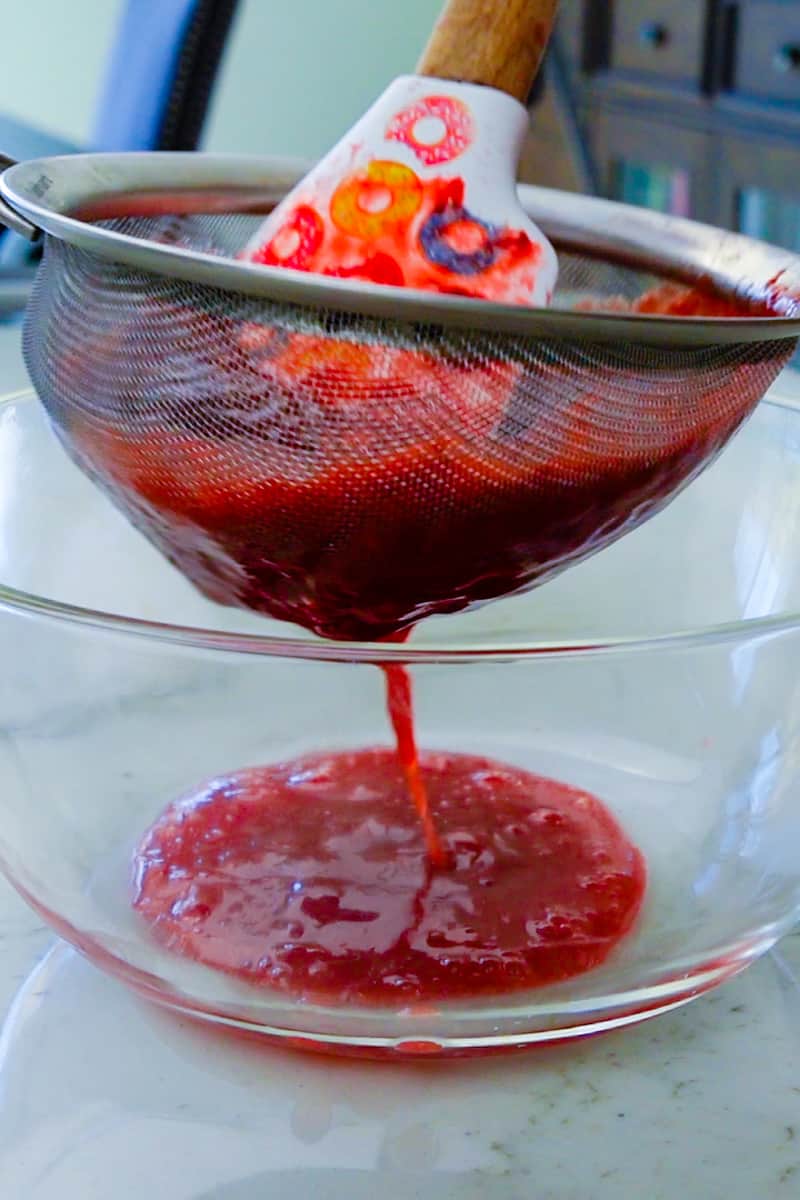
Step 4. Store in a jar and cool before using.

Ok, ready to cook? Check out my strawberry puree recipe below:
Video
Honors Members Section
This extra material is accessible to Sugarologie Honors members.
Become a member to view extended research notes, technique analysis, and supplemental materials! Learn more about Sugarologie Honors here.
Already a member?
Before starting the recipe, please read this!
Measure by weight, if possible.
Measuring by weight is the best way for you to replicate my recipes. I develop recipes using ingredients (even liquids) measured in grams, which is why you see them listed first in the recipe cards. For measurements under 5 grams, I will typically only list the volumetric measurements (teaspoons, etc.), as most home scales are not precise for such small weights.
In most cases, I have converted grams to volumetric measurements (aka US customary units) for bakers who prefer this method. However, the measurements are not as precise and may have awkward proportions. The recipes should still work, but for the ultimate precision, try to use weight.
This is the OXO scale I use daily. I also purchased this budget version of a good scale, which I keep at my Mom’s house for baking. If you’re interested in other tools I use for my baking, I’ve compiled a list here.
Use room temperature ingredients.
All my ingredients should be used at room temperature, or 65-75 °F/18-24 °C. I will always indicate if you need something outside this range. If no details are given, room temperature is the default.
Pay attention to the ingredient descriptions.
I try not to be brand-specific, but I will always note an interesting result from a type of ingredient, be it negative or positive.
A specific note regarding salt: I use Diamond Crystal Kosher salt for everything on this site except for frostings. In frostings, you want the salt to dissolve more easily, and kosher salt tends to leave granules behind. If you substitute table salt (more finely granulated) for recipes that list kosher salt, you must use half the volume indicated in my recipes.
Substitutions are hard.
That said, substitutions aren’t impossible but can be the toughest part of recipe development. Small swaps, like reduced-fat milk (2% fat) for whole milk (3.5% fat), usually work fine. However, bigger changes—such as replacing oil with applesauce or sour cream with Greek yogurt—can significantly impact texture and density.
Be wary of general, all-purpose substitutions in baking; I find that usually there is never a one size-fits-all solution. I carefully select ingredients for my recipes, so for the best results, start with the original recipe and modify with caution.
Read all the recipe instructions before beginning.
I’m in the “Pre-read the Chapter before Class Lecture” club... and I invite you to join! Baking new recipes can be intimidating, so let’s set you up for success. I want you to think about timeframes. Most fillings and frostings can be made ahead of time, and give you an extra day for mental space. Also, as you become a more proficient baker, you can anticipate and recognize steps. (“Oh, this has a meringue step, so I’ll need an extra clean bowl…” etc.) Ensure you go down the ingredient list and have everything at the right temperature.

Strawberry Puree




- 453 g (16 oz) fresh or frozen strawberries
- 50 g (1/2 cup) white granulated sugar (or brown)
- 1 tsp lemon juice (optional)*
- 453 g (16 oz) fresh or frozen strawberries
- 50 g (1/2 cup) white granulated sugar (or brown)
- 1 tsp lemon juice (optional)*
- Cook the berries.
Place fresh or frozen strawberries in a small saucepan with sugar and lemon juice (if using). Cover and cook on medium-low heat, stirring a few times to ensure the sugar is not sticking to the bottom of the pan. Periodically uncover and use a potato masher or fork to break them up and cook until you have a thick strawberry sauce. - Thicken the strawberry sauce.
Remove the cover and reduce the water by cooking for about 5 more minutes at medium-low (it may take up to 10 minutes if you use frozen berries). There's no wrong consistency here - so keep cooking until you like the consistency. - Adjust for taste and texture.
Add some more sugar to the hot strawberry puree if you're looking for a sweeter puree. If you want more acidity, add a bit more lemon juice.
If you need super smooth puree, you can strain their purée to get rid of seeds or leftover strawberry solids. - Store for up to a few weeks.
Add to a glass or other heat-proof container (be careful - it's hot!) and set aside to cool before using. Keep in the fridge for a few weeks or in a freezer-safe container for at least a few months.

Recipe Card - Adriana's Notes
*Lemon juice adds additional acid to the strawberry puree, which aids in flavor as well as maintaining a red color. You can also use a pinch of citric acid.

.avif)
.avif)
.avif)
%20(1).avif)


